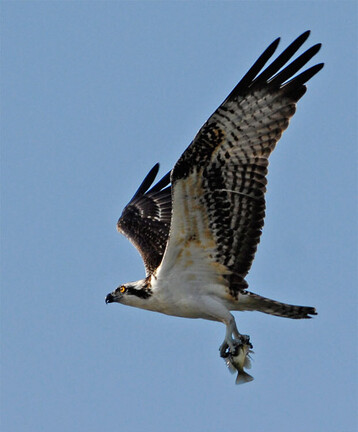Current Nature: Return Of The Osprey
Seth Engelbourg •

Spring on Nantucket is a period of rebirth after a long, cold winter. Warmer temperatures, budding flowers, and the reopening of your favorite restaurants are all welcomed sights. Everyone has their most anticipated signs of spring: it may be daffodils blooming, striped bass returning to the harbors, or the chance to plant your vegetable garden. Here at the Linda Loring Nature Foundation, one spring moment reigns supreme, the annual return of our nesting ospreys.
The osprey (Pandion haliaetus) is a unique raptor found across most of our world. Also known as the "Fish Hawk," these birds are equipped with several adaptations that make them extraordinarily successful at hunting their prey; 99 percent of their diet is made up of fish. Their talons have backward-facing scales, similar to the barb on a fishing hook, preventing the fish from escaping once caught. Their nostrils are closable to keep water out during dives. They have three sets of eyelids, including a nictitating membrane, which acts like swim goggles and allows them to see well underwater. They can even rotate their shoulders once they catch a fish to hold it parallel to their body, reducing drag and making for more aerodynamic flight. Truly, ospreys are masters of the aquatic environment.

Like many raptors in North America, osprey almost went extinct in the 1960s due to the widespread use of DDT insecticide, which had the side effect of reducing the osprey’s eggshell thickness. This caused eggs to be weak and either break or hatch prematurely, leading to rapid population decline. Once DDT was banned, their populations came roaring back in many locations and were aided by conservation organizations building artificial nest platforms for them to use. The natural nesting habitat for ospreys is tall standing, dead tree snags, which are rare on Nantucket given our grassland and heathland-dominated island ecosystems. Therefore, these artificial nest platforms were essential for aiding the osprey population’s re-growth locally. Today, Nantucket’s osprey population is robust, with almost all the nest platforms occupied annually and a small number of natural tree snag nesting sites. Here at the Linda Loring Nature Foundation, we have adopted the symbol of an Osprey nest as our organizational logo; we happily maintain and monitor three platforms on our property inhabited by ospreys each year.
Each year, ospreys spend their breeding season on Nantucket and their offseason in Central or South America. They generally return to the island around late March or early April. Last year, we had a public guessing contest to predict the date of the first sighting of the returning osprey. It ended up being March 22nd, which was a present for me as that is my birthday! We will see if the osprey returns on the same date or a different one this year. Join the fun and participate in our 2023 arrival date contest here. Keeping track of annual arrival dates is an example of phenology, or the study of nature’s timing, which is a major focus of LLNF’s research program.
Ospreys mate for life and return to the same nest site each year. Males typically arrive on Nantucket first to claim and spruce up their nest before the females, who generally follow about a week later. As you read this column, it is likely that some of our resident ospreys have already begun their northward migration and are on their journey back to the island.

The breeding season for ospreys is intense. Some birds, like the American Robins, complete their entire nesting cycle in five weeks. A nesting cycle is the time period from when a nest is first built until the time when chicks fledge. However, ospreys require at least five months to raise their offspring. Each pair generally lays two eggs but sometimes up to four. Once the chicks hatch, the parents must consistently hunt for their family, often catching ten or more fish per day to meet the energy demands of their offspring. One fun fact about ospreys is that males and females winter in separate tropical locations. Who could blame them? After all, the stress of constantly feeding and protecting their babies for months sounds exhausting. Maybe those with children to care for should be more like the ospreys and have a special solo vacation in the tropics each winter to rest and recharge.
If you want to learn more about these majestic birds, plan to attend one of LLNF’s Birding Field Trips this year, starting in early May. Or you can check out Nantucket’s eBird records for information on when and where to look for them. If you think you are the first to see an Osprey on island this spring, please email us at the Linda Loring Nature Foundation!
Seth Engelbourg is the Naturalist Educator and Program Manager at the Linda Loring Nature Foundation.
Stay tuned for more editions of Current Nature, a bi-weekly column featuring seasonal topics, natural history information, and advice on the outdoors from the staff at the Linda Loring Nature Foundation.